search page - text search
search page - Assig.orig, Assg.curr
search page - Priority, Expiry
search page - Ref.by
search page - Ind.cl
search page - Entity
search page - Type
search page - Maint.status
search page - Score
search page - Current assig.owns
search page - search button
search page - open 10 button
search page - clear button
search page - arrow button
search page - search results
search page - URLs
patent page - underlines
patent page - reorder
patent page - links
patent page - priority, expiry
patent page - inventors
patent page - assignees
patent page - Assignees
patent page - Entity
patent page - References
patent page - maintenance
patent page - headings
patent page - formulas
patent page - term look up
Seach page is the main patentcut.com page. This is the text box:

You can paste any text here - whole newspaper articles, web pages,
search results, Excel content, text editor content etc.
No need to worry about format or extra text - just copy and paste.
Patent numbers can be of any shape, like so:

As soon as the content is pasted, patent links are created on the bottom of the page:

Instead of pasting, you can type patent numbers by hand as
well.
Links are regenerated whenever Enter is pressed or more content is pasted.
Links to patents visited in the past are of different colour. Very useful when doing e.g. prior art search.

If any patents are dumped in the text box, the subsequent searches are over just these patents.
Handy when you need to work on a set of patents.
All without the hassle of uploading files, creating projects, reformatting numbers or offering sacrifices to a higher power.
You can search different patent sections:
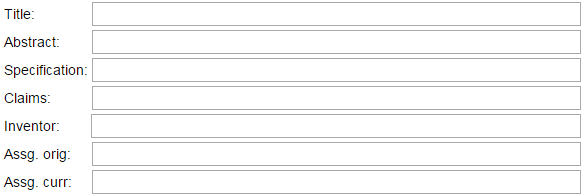
Use quotes to search phrases, use - to exclude from a search (NOT), use | for OR:

Assg. orig pertains to the original patent owner. Assg. curr is the current owner.
E.g. to list patents created and sold by Nokia:

This information is generated from Assignement records and application forms.
Software can misinterpret this information and generate incorrect data.
If in any doubt, verify with the USPTO assignement data.
E.g. list patents with at least 2 years of life left:

Or patents with priority older than Mar. 31, 2000:

"From" fields go as early as possible, whereas "to" fields go as late as possible.
E.g.In the above example for the expiry, the search will grab all patents with the expiry of Jan. 1, 2018 on.
The priority example will grab all the patens with the priority up to Mar. 31, 2000.
E.g. search for patents referenced by at least 40 other patents:

E.g. search for patents whose shortest independent claim is shorter than 300 characters:
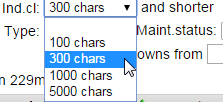
E.g. search for patents whose current assignee is declared as a Micro entity:

This data is derived from the latest maintenance fee paid.
The usual suspects:
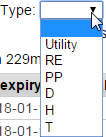
Status of the maintenance fees:
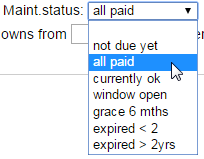
all paid - 4, 8 and 12 year fees all paid.
currently ok - 4 or 8 year fee paid and not due yet.
window open - window to pay the fee is currently open (3 to 3.5 years since issue, 7 to 7.5 or 11 to 11.5).
grace 6 mths - Fee still not paid, 6 months grace period to pay the fees open. (3.5 to 4, 7.5 to 8, 11.5 to 12 years since issue)
expired < 2 - Patent is expired due to non payment, but it is still not full 2 years since expiry. The patent can still be revived as unintentional non-payment.
expired < 2yrs - Patent is expired due to non payment, with more than 2 years since expiry. The patent can be revived as unavoidable non-payment only.
Automated score. Calculated on the basis of forward references and claim length. 1% means the top 1% (the best)
E.g. list only patents in the top 10%:

The number of patents owned by the current owner.
E.g. list only patents owned by owners with no more tha 300 patents in their arsenal:

The number of patents owned by the current owner.
E.g. list only patents owned by owners with no more tha 300 patents in their arsenal:

Invokes the search. Up to 1000 patents are returned at one time.

Pressing "open 10" again opens the next 10 patents in the list.
You may have noticed that each patent tab shows an icon with the three last digits of the patent number
No more asking which tab hides which patent!
By the way, all content is compressed => and there is no behind-the-scenes exchange of who-knows-what-data between your browser and the server.
You have faster downloads and you won't burn through your data plan.Chrome doesn't allow more than 1 tab by default. To enable this in Chrome, click "open 10", return to the Search window (with the pC icon), click on the warning at the end of the address bar, allow popups.
Internet Explorer can be cajoled into opening tabs by doing: Tools, Internet Options, Change how webpages are displayed in tabs, When a pop-up is encountered: Always open pop-ups in a new tab.
Firefox should not give you problems.
Opens 10 patents from the list. The patents are opened in new tabs. Usually, browsers will try to prevent this. You need to allow pop-ups from patentcut.com for this to work.
Clears all the search fields.
Hides/Unhides the search fields.

When patents are pasted or entered in the text box, only the patent numbers are listed:

The patents are listed in the order they appear in the text box
When search is invoked, more data is listed:

In this case, the patents are sorted on the score field - the highest scoring patents first.
You can sort on any field.
To export the list, simply copy: (start from where the cursor is shown to grab the heading row too)

and paste: (into a spreadsheet, text editor, Power Point, email...)

If you need only the patent numbers, simply copy the whole page (crl-a, crl-c) and paste it into the text box on top (ctrl-v).
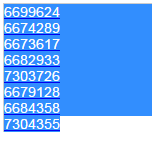
patentCut does not lock you into a proprietary format nor does it require votive offerings to release your data.
You may have noticed that the web page address changes as you enter sarch terms.
E.g.

results in:

You can copy the URL and save it or send it. When you click on it, the search fields and the list are populated as it was originally.
But don't take my word for it - try it:
http://patentcut.com/?&title=test&abstract=illustration
This works for patents entered in the text box as well. Just copy the above page content and dump it into the text box. Click "search" and presto:
http://patentcut.com/?&title=test&abstract=illustration&p0=5787114&p1=5956370
You can do this with up to 1000 patents!
Again, don't take my word for it - try it:
list of 1000 patents
Who needs the hassle of uploading files, creating projects, reformatting numbers?
The underlined text is the repeating text in the independent claims. This should help with grasping the content more quickly. For example "incident radiation" is mentioned twice in this claim:

Sometimes underlines are handy to spot the differences between claims. For example the difference between claim 1 and claim 7 is the text that is not underlined.

Use the checkboxes to better choose what is underlined. Each checkbox controls one quarter of the underlines. The leftmost controls the longest and the rightmost the shortest ones.
Like so:



Independent claims are on top, sorted by the length. This saves you the trouble of finding the shortest independent claim.
To reorder the claims, use
![]()
Shortest first:

Reordered:


"PTO" is the link to the patent on the USPTO site.
"PTO PDF" links to the pdf version on the USPTO site. Reasonably fast.
"Espacenet" is the link to the European Patent Office. Most useful to find family members or verify legal status.
Google links below point to Google's servers. "PAIR" link points to the patent file wrapper. One click delivers all the file wrapper documents to your browser. Unfortunately, this doesn't work for older patents (pre 2001) and is missing for some newer ones too.
If you use any of these links, you may be tracked.
patentCut does not track you.
patentCut does not share or resell user data with any other company, organization or individual.
patentCut uses no cookies.
![]()
Priority date is the oldest priority of all the dates it inherits from: provisional, non-provisional, foreign, PCT.
Priority may not be correct. For example, some dates are parsed from the text of the specification and the result may not be correct. Also, if priority is inherited from another patent which draws priority from yet a third patent and if not all dates are entered in the USPTO documents, the date is incorrect.
Do not rely on the priority dates for RE patents.
![]()
Expiry is calculated according to the applicable rules, nicely summarized on Wikipedia:
For applications filed on or after June 8, 1995, the patent term is 20 years from the filing date of the earliest U.S. or PCT application to which priority is claimed (excluding provisional applications). For applications that were pending on and for patents that were still in force on June 8, 1995, the patent term is either 17 years from the issue date or 20 years from the filing date of the earliest U.S. or PCT application to which priority is claimed (excluding provisional applications), the longer term applying."
For Design patents, the expiry is 14 years after the filing.
Term Extensions are taken into account when calculating expiry, but Terminal Disclaimers are not.
If Terminal Disclaimer applies, orange "TERM.DISC." text appears below the expiry date:

Red if expired:
![]()
Expiry may not be correct. For example, if priority is incorrect, expiry is likely to be incorrect also.
Do not rely on the expiry date for RE patents.

shows the first named inventor.
 opens a new search with the list of all the inventor's patents.
opens a new search with the list of all the inventor's patents.
 jumps to the full list of inventors on the bottom of the page:
jumps to the full list of inventors on the bottom of the page:

Clicking on any of the names brings up their respective patents.
Clicking on "INVENTORS" brings you back to the top of the page
 opens a new searh with patents AMD currently owns. The search is cleaned up of redundant words like INC., Corp., LTD etc. to give more accurate results. Different names are not supported though - "AMD" and "Advanced Micro Devices" are treated as different companies.
opens a new searh with patents AMD currently owns. The search is cleaned up of redundant words like INC., Corp., LTD etc. to give more accurate results. Different names are not supported though - "AMD" and "Advanced Micro Devices" are treated as different companies.
"Assg.orig" is the original assignee of the patent.
"Assg.curr" is the current assignee of the patent, according to USPTO Assignment records. Clicking on it brings you to the page bottom with all the assignment records for the patent:

Clicking on the any of the names opens a new search with the patents currently assigned it.
Current assignee information may not be correct in all cases. The best is to verify by using:

Large, Small or Micro - as declared when the last maintenance fee was paid.
"Referenced by" shows the number of patents this patent is referenced by (forward references). Clicking on it brings you to the list on the bottom of the page:

"References" shows the number of patents which this patent references (backward references). Clicking on it brings you to the list on the bottom of the page:

Maintenance status can be one of::
all paid: all three fees paid (3.5, 7.5 and 11.5 years)currently ok: current fees paid or no fees due yet
window open: payment window open, no payment in records
expiring-grace: payment overdue, but still inside the 6 months grace period
expired< 2yrs: expired due to non-payment, might still be able to recover
expired> 2yrs: expired due to non-payment, likely unrecoverable
Red if expired or expiring:

 brings you to the very bottom of the page where you can see maintenance events:
brings you to the very bottom of the page where you can see maintenance events:

Below, you will find important Future Dates for Fee payments:

"CROSS REFERENCE TO R...", "BACKGROUND OF INVENT..." etc. are
links to headings in the specification.
After you click on the link, clicking on the heading brings you back to the top.
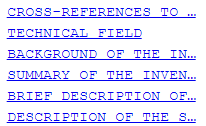
Would you like to see what the problem is that the invention is trying to solve?
Click the 'Brief Summary of the Invention' link to take you right there,
and then click again to come right back to the top.

Mathematical formulas are handled nicely in FireFox (Chrome and Internet Explorer - not so much):

including superscripts, subscripts, Greek letters:

Reissued patents are formatted for human, not cyborg consumption. Deleted text is overstrike, and inserted is italic:

You can easily look up a term in the patent. Simply double click on a word, or select a phrase:

A popup list opens the lines in the patent body containing the word or phrase:

Click on the line that looks interesting. It brings you to the patent body text. Click anywhere to go back to the popup list.

To get rid of the popup list, click "close" or press Esc.
Note: If more than 50 characters are selected, the lookup does not get activated. The lookup list shows only 30 first matches in the patent body.
Contact
Contact: info@patentCut.com
